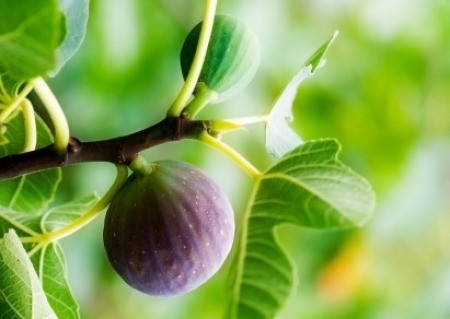
Fig trees do best in the southern half of the country, but they can also be grown in protected locations along the Atlantic coast as far north as New York. In colder climates, or for gardeners with limited growing space, growing them in containers is a practical and increasingly popular option.
Figs are not difficult to grow, but if you ask ten different fig growers how to grow them, it's likely that you'll get ten different answers. Growing requirements will vary a bit depending on local climate conditions and the variety of fig tree you select, so it can take a bit of trial and error to find out what works best. Container-grown figs are most productive when placed in full sun. Because they rely on you to meet their needs, they will require more water and fertilizer than fig trees grown in the ground.
The size container you need depends largely on how large your fig tree is to start with. Many people start with the size their fig tree comes in from the nursery and re-pot one size up each year until they reach a 15 to 20 gallon container (anything over 30 gallons may be too heavy to move). Here are a few things to consider when choosing your container:
Fig trees aren't particularly picky about the soil they are grown in - as long as it drains quickly and it is not too acidic (pH of 6.0-7.0). An example of a good mix would be 2 parts pine bark (large chunks sifted out), 1 part well composted manure, 1 part Perlite, and a handful of ground limestone. There's no need to complicate things though. Commercial potting mixes formulated for containers will work fine. Just make sure the soil drains well.
To maintain good growth and produce fruit, fig trees need consistent water throughout the growing season. Keep trees well watered through the summer and do not let them dry out or become stressed. (Drought stressed trees may drop leaves and fail to produce fruit.) By the end of August you will want to start cutting back slightly on the water to reduce fruit splitting.
Like other container-grown plants, regular applications of fertilizer are necessary for potted fig trees to maximize their performance. Use a slow release organic fertilizer to avoid rapid leaf growth at the expense of fruit production. This can be applied in the spring and continued throughout the summer according to directions. Stop fertilizing by mid-August to let existing growth slow and harden off before winter storage.
Top Pruning: When trees are young, they may require some pruning in order to develop a strong framework of branches. Since fruit grows on terminals of the previous year's wood, avoid heavy pruning once the tree becomes established.
Root Pruning: In general, fig trees tend to perform better when their roots are somewhat constricted. Once they are in their largest pot, they need to be root pruned once every three to four years. To do this, take the tree out of the pot and cut one-quarter of the roots away to make a root ball before returning it to a pot of fresh soil. Root pruning should always be should be done while the plant is dormant (has no leaves); either in the early spring or late fall.
In cold climates, container figs need to be given protection over winter. In late fall, after frost has caused the leaves to drop, move containers into a frost-free unheated garage or shed where they will be protected from the wind. Ideally, the temperature should remain above 20 degrees F, but below 45 degrees. If an unheated and unattached garage is your only option, the tree should be wrapped before storing.
Water the tree very sparingly (a cup or two) every four weeks during winter storage to prevent the root from drying out. A dormant tree does not need light so don't worry about storing it in total darkness. Plants can be moved outdoors once overnight temperatures consistently remain above freezing.
Take care when selecting a fig cultivar for your area. There are varieties that are adapted to perform best in certain regions of the country. Don't rely on national chains and big box garden centers to sell you the right variety for you growing zone. Local nurseries are your best and most reliable source for finding out which types will perform best.
One tree is usually enough to provide figs for the average family. The most common type of fig trees grown by gardeners are Persistent (or Common) figs. These do not need pollination to set crops. Examples of good overall cultivars to consider for cool to cold climates include Brown Turkey, Celeste, Hardy Chicago, LSU Purple, and Violet de Bordeaux.

About The Author: Ellen Brown is an environmental writer and photographer and the owner of Sustainable Media, an environmental media company that specializes in helping businesses and organizations promote eco-friendly products and services.
Add your voice! Click below to comment. ThriftyFun is powered by your wisdom!
We repotted our young fig tree this year using a half 'whiskey barrel' style container. All was well for 3 months and now random leaves are curling up, have yellow areas and seem dry. All the other leaves are fine! What should I do?
Add your voice! Click below to comment. ThriftyFun is powered by your wisdom!